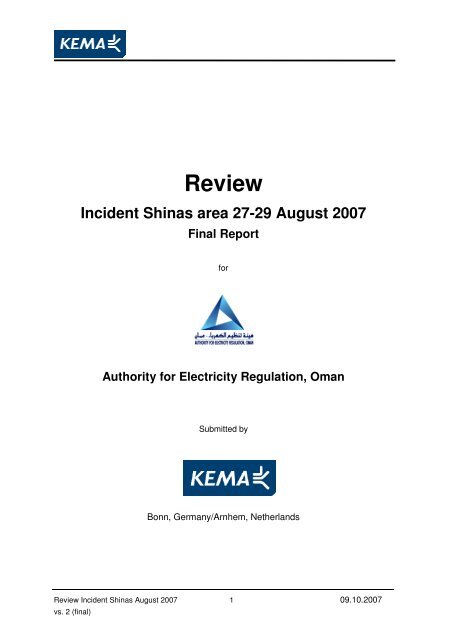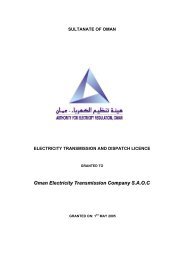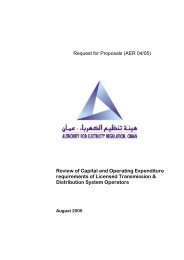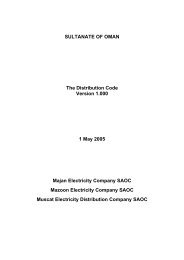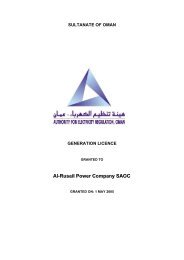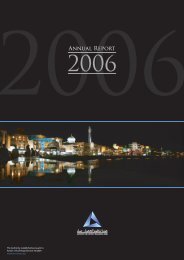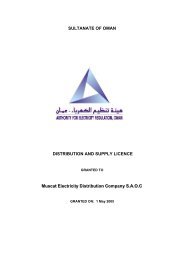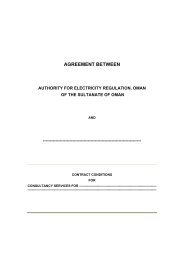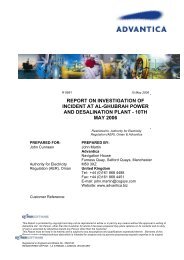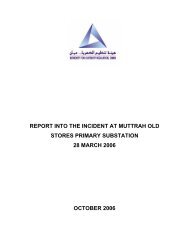Review Incident Shin.. - authority for electricity regulation, oman
Review Incident Shin.. - authority for electricity regulation, oman
Review Incident Shin.. - authority for electricity regulation, oman
Create successful ePaper yourself
Turn your PDF publications into a flip-book with our unique Google optimized e-Paper software.
<strong>Review</strong><br />
<strong>Incident</strong> <strong>Shin</strong>as area 27-29 August 2007<br />
Final Report<br />
<strong>for</strong><br />
Authority <strong>for</strong> Electricity Regulation, Oman<br />
Submitted by<br />
Bonn, Germany/Arnhem, Netherlands<br />
<strong>Review</strong> <strong>Incident</strong> <strong>Shin</strong>as August 2007 1 09.10.2007<br />
vs. 2 (final)
Executive Summary<br />
On 27 August 2007, at 22.07h a fault on the 132 kV-line of the Oman Electricity Transmission<br />
Company SAOC (OETC) from Wadi Jizzi to <strong>Shin</strong>as led to an interruption of the power<br />
supply in the <strong>Shin</strong>as area. This area was completely without power until 07.35 h the following<br />
day, when the supply was partly restored via the 33 kV feeders of Majan Electricity<br />
Company SAOC (MJEC) using a rota load shedding scheme. The <strong>Shin</strong>as 132 kV grid station<br />
was energized again by OETC at 23.55 h on 28 August 2007. After that MJEC restored<br />
the supply to all customers, which was completed at 01.34 h on 29 August 2007.<br />
The Authority <strong>for</strong> Electricity Regulation, Oman (the Authority) asked KEMA to identify the<br />
technical reasons <strong>for</strong> the interruption and investigate the overall management of the incident<br />
by OETC. The Authority is of the view that the time taken by OETC to restore supplies<br />
was unduly excessive.<br />
We have studied several documents, including the incident reports/sequence of events of<br />
both OETC and MJEC. Furthermore, we have interviewed representatives of both OETC<br />
and MJEC, including both General Managers, OETC’s maintenance manager, representatives<br />
of OETC’s Load Dispatch Center and responsible people on-site, such as OETC’s operation<br />
engineer and MJEC’s local staff in the Sohar area.<br />
The conclusions of our review can be summarized as follows:<br />
<br />
<br />
<br />
<br />
<br />
the duration of the outage was influenced by a number of factors: the most important<br />
being that the Wadi Jizzi – <strong>Shin</strong>as line was not (n-1) compliant as required by Oman<br />
Transmission Security Standards and international best practice;<br />
OETC was aware the Wadi Jizzi – <strong>Shin</strong>as line was not (n-1) compliant but did not have<br />
a comprehensive plan in place to detect faults. Fault distance indicators installed at the<br />
Wadi Jizzi grid station could have reduced the time taken to locate the fault and reduce<br />
the duration of the supply interruption;<br />
Since we have only seen an expired maintenance contract, we are unable to confirm<br />
that a maintenance contract <strong>for</strong> the Wadi Jizzi – <strong>Shin</strong>as line was in place at the time of<br />
the incident;<br />
spare parts were not immediately available on site and had to be transported from remote<br />
locations. This contributed to the supply interruption being longer than necessary.<br />
The fault was located at 1.00 am whereas spare parts arrived on-site at 4.30 pm. Some<br />
14 hours was lost by not having spare parts available close to the site;<br />
organization of the emergency response ef<strong>for</strong>t was ad-hoc and poorly organized - it was<br />
not always clear who was in charge <strong>for</strong> coordinating the restoration activities and some<br />
<strong>Review</strong> <strong>Incident</strong> <strong>Shin</strong>as August 2007 2 09.10.2007<br />
vs. 2 (final)
necessary safety measures such as line earthing in both the Wadi Jizzi and the <strong>Shin</strong>as<br />
grid stations were not immediately implemented. OETC did not have a complete set of<br />
defined System Normalisation procedures and System <strong>Incident</strong> procedures in place as<br />
required by the Grid Code of Oman (OC 7, Contingency Planning Code, version 1.000).<br />
Restoration time could have been significantly reduced if appropriate procedures had<br />
been in place;<br />
We recommend that:<br />
<br />
<br />
<br />
<br />
<br />
OETC expedite the construction of a second circuit to <strong>Shin</strong>as to secure n-1 compliance;<br />
immediate implementation of the Contingency Planning Code of the Grid Code;<br />
further development of LDC procedures, and immediate implementation of the already<br />
identified training procedures and training plan;<br />
OETC include special measures (such as manual re-closing) <strong>for</strong> non-(n-1) compliant<br />
lines in dedicated procedures;<br />
Develop special arrangements with the Royal Oman Police <strong>for</strong> emergency situations;<br />
KEMA’s assessment has identified serious problems in the preparation <strong>for</strong> and the handling<br />
of the incident by OETC management. We believe it is fair to say that the impact of the incident<br />
could have been limited to a significant extent if proper preparation was in place and a<br />
more prompt and adequate response had followed. Our review reveals a significant scope<br />
<strong>for</strong> improvement to be achieved in future in order to bring the quality of operations within<br />
OETC to a level in line with what could reasonably be expected from a transmission operator<br />
operating within the Oman <strong>electricity</strong> market.<br />
<strong>Review</strong> <strong>Incident</strong> <strong>Shin</strong>as August 2007 3 09.10.2007<br />
vs. 2 (final)
TABLE OF CONTENTS<br />
1. Introduction 5<br />
2. Be<strong>for</strong>e the incident 6<br />
2.1. Network.............................................................................................................. 6<br />
2.2. Preparedness <strong>for</strong> a fault in the Wadi Jizzi – <strong>Shin</strong>as line ..................................... 7<br />
2.2.1. Shorten the time <strong>for</strong> finding the fault .............................................................. 8<br />
2.2.2. Spare parts available..................................................................................... 8<br />
2.2.3. Repair Tools available ................................................................................... 8<br />
2.2.4. People available ............................................................................................ 9<br />
2.2.5. Maintenance Contract ................................................................................... 9<br />
2.2.6. Conclusion..................................................................................................... 9<br />
2.3. System Operation ............................................................................................ 10<br />
2.4. Emergency organization .................................................................................. 11<br />
3. <strong>Incident</strong> 12<br />
3.1. Immediately be<strong>for</strong>e the incident........................................................................ 12<br />
3.2. Immediately after the incident .......................................................................... 12<br />
3.3. Looking <strong>for</strong> the fault location ............................................................................ 13<br />
4. Repair of the Fault and Restoration of Supply 14<br />
4.1. Fault location.................................................................................................... 14<br />
4.2. Evaluation of the damage................................................................................. 14<br />
4.3. Spare parts ...................................................................................................... 15<br />
4.4. Police reporting and rest .................................................................................. 15<br />
4.5. Repair of the line.............................................................................................. 16<br />
4.6. <strong>Incident</strong> center ................................................................................................. 17<br />
4.7. Restoring energy supply via back-feeding........................................................ 17<br />
4.8. Restoring energy supply after repair ................................................................ 18<br />
5. Conclusions 19<br />
<strong>Review</strong> <strong>Incident</strong> <strong>Shin</strong>as August 2007 4 09.10.2007<br />
vs. 2 (final)
1. INTRODUCTION<br />
On 27 August 2007, at 22.07h a fault on the 132 kV-line of the Oman Electricity Transmission<br />
Company SAOC (OETC) from Wadi Jizzi to <strong>Shin</strong>as led to an interruption of the power<br />
supply in the <strong>Shin</strong>as area. This area was completely without power until 07.35 h the following<br />
day, when the supply was partly restored via the 33 kV feeders of Majan Electricity<br />
Company SAOC (MJEC) using a rota load shedding scheme. The <strong>Shin</strong>as 132 kV grid station<br />
was energized again by OETC at 23.55 h on 28 August 2007. After that MJEC restored<br />
the supply to all customers, which was completed at 01.34 h on 29 August 2007.<br />
The Authority <strong>for</strong> Electricity Regulation, Oman (the Authority) asked KEMA to identify the<br />
technical reasons <strong>for</strong> the interruption and investigate the overall management of the incident<br />
by OETC. The Authority is of the view that the time taken by OETC to restore supplies<br />
was unduly excessive.<br />
We have studied several documents, including the incident reports/sequence of events of<br />
both OETC and MJEC. As background documents we used the Grid Code (vs. 1.000) and<br />
the ‘Report on capital and operating expenditure requirements <strong>for</strong> the Oman <strong>electricity</strong><br />
transmission company <strong>for</strong> the period 2006 - 2010’ 1 .<br />
Furthermore, we have interviewed representatives of both OETC and MJEC, including both<br />
General Managers, OETC’s maintenance manager, representatives of OETC’s Load Dispatch<br />
Center and responsible people on-site, such as OETC’s operation engineer and<br />
MJEC’s local staff in the Sohar area.<br />
This document reviews the event largely in chronological order. We start with a review of<br />
the situation be<strong>for</strong>e the incident took place (chapter 2). After that, we review the activities<br />
during and immediately after the incident in chapter 3. Chapter 4 covers all the restoration<br />
and repair activities. Our concluding remarks are contained in Chapter 5.<br />
1 by SKM <strong>for</strong> AER, July 2006<br />
<strong>Review</strong> <strong>Incident</strong> <strong>Shin</strong>as August 2007 5 09.10.2007<br />
vs. 2 (final)
2. BEFORE THE INCIDENT<br />
In this chapter we discuss the status-quo of the network, organization and staff in relation to<br />
the incident. There<strong>for</strong>e we are reviewing whether OETC was properly prepared <strong>for</strong> the fault<br />
and its consequences.<br />
2.1. Network<br />
The 132 kV <strong>Shin</strong>as grid station is connected to the Main Interconnected System by one<br />
single-circuit 132 kV-line, coming from Wadi Jizzi. In the <strong>Shin</strong>as grid station two 63 MVA<br />
132/33 kV-trans<strong>for</strong>mers feed the 33 kV-network <strong>Shin</strong>as operated by MJEC. This 33 kVnetwork<br />
has interconnections to other 33 kV networks of MJEC. These connections provide<br />
a limited back-feed via the underlying 33 kV-network. However, the back-feed is only available<br />
after rearrangements of the 33 kV-network and load-shedding in the <strong>Shin</strong>as area and<br />
elsewhere. There<strong>for</strong>e the 33 kV-network only provides limited redundancy in the event of<br />
the single-circuit 132 kV-line tripping. It can there<strong>for</strong>e be concluded that the supply to the<br />
<strong>Shin</strong>as 33 kV network does not meet the Security Standard criteria of (n-1).<br />
According to the (proposed) Oman Transmission Security Standards 2 , demand groups of<br />
20 to 100 MW should be restored immediately after a first outage ((n-1) Security Standard).<br />
Since the load of the <strong>Shin</strong>as network can reach 65 MW (<strong>for</strong>ecasted load <strong>for</strong> 2007) loss of a<br />
single line, which has to be repaired be<strong>for</strong>e the load can be restored, does not meet these<br />
Security standards.<br />
The (proposed) Security standards in Oman are similar to Security standards in many Grid<br />
Codes. However, in contrast to the Oman Transmission Security Standard, some grid<br />
codes and/or design standards accept losing load if it is only <strong>for</strong> automatic or manual<br />
switching activities taking a few minutes. E.g. the GB Security and Quality of Supply Standard<br />
specifies that <strong>for</strong> interruptions of loads (‘group demands’) up to 60 MW, two-thirds of<br />
the load has to be restored within 15 minutes. Nevertheless, since there are no possibilities<br />
to quickly restore the load in the <strong>Shin</strong>as area by fast switching actions, the network design<br />
would also not have met this type of standard.<br />
2 See section 6.2 of the ‘Report on capital and operating expenditure requirements <strong>for</strong> the<br />
Oman <strong>electricity</strong> Transmission Company <strong>for</strong> the period 2006 - 2010’, by SKM, July 2006.<br />
<strong>Review</strong> <strong>Incident</strong> <strong>Shin</strong>as August 2007 6 09.10.2007<br />
vs. 2 (final)
We were told that the investment in a second circuit to the <strong>Shin</strong>as grid station was already<br />
planned during the time that the Ministry of Housing Electricity and Water was the operator<br />
of the transmission network, ie there were plans <strong>for</strong> a second circuit to <strong>Shin</strong>as be<strong>for</strong>e 1 May<br />
2005 3 . According to OETC’s investment plan <strong>for</strong> 2006 4 a second 132 kV-circuit to the <strong>Shin</strong>as<br />
grid station had been planned <strong>for</strong> construction in 2006. We understood from OETC 5<br />
that this project had been delayed because it was combined with the investment in a new<br />
grid station in Liwa, which increased the efficiency of this investment. OETC confirmed that<br />
the construction of a second circuit to <strong>Shin</strong>as is now in the tendering phase. However, we<br />
have not seen any proof of this.<br />
It can be concluded that if there had been a second 132 kV-circuit to <strong>Shin</strong>as, the fault would<br />
not, under normal operating conditions, have caused an outage since the second feeder<br />
would have been capable of supplying the entire load. For the peak demand of the <strong>Shin</strong>as<br />
area (65 MW <strong>for</strong>ecasted <strong>for</strong> 2007) this situation is unacceptable according to international<br />
and Oman standards. This has been recognized by OETC and its predecessors <strong>for</strong> many<br />
years (be<strong>for</strong>e 2005) and KEMA strongly recommend that the contract to provide <strong>for</strong> n-1 is<br />
implemented on an expedited basis.<br />
2.2. Preparedness <strong>for</strong> a fault in the Wadi Jizzi – <strong>Shin</strong>as line<br />
The reason why, in general, the (n-1) criterion is applied is that there is a reasonable risk<br />
that faults in lines, trans<strong>for</strong>mers, generators etc will occur. This risk combined with the<br />
damage of losing load results in the need to invest to provide additional redundancy of system<br />
elements e.g. lines, trans<strong>for</strong>mers etc. Security Standards allow <strong>for</strong> and even require<br />
large investments to provide (n-1) security in transmission networks.<br />
Following this logic, situations in which these standards are not met should be considered<br />
very seriously. For these situations in which a single fault will lead to an outage with significant<br />
loss of load <strong>for</strong> a long duration (the repair time) there should be detailed and comprehensive<br />
plans.<br />
Since it was recognized by OETC (see section 2.1) that the (n-1) security criterion was not<br />
met <strong>for</strong> the Wadi Jizzi – <strong>Shin</strong>as line, then there should have been a plan in place to deal<br />
3 1 May 2005 is the date OETC took over the responsibility of the transmission network.<br />
4 See section 7.2 of the ‘Report on capital and operating expenditure requirements <strong>for</strong> the<br />
Oman <strong>electricity</strong> Transmission Company <strong>for</strong> the period 2006 - 2010’, by SKM, July 2006.<br />
5 Interview on 1 September 2007.<br />
<strong>Review</strong> <strong>Incident</strong> <strong>Shin</strong>as August 2007 7 09.10.2007<br />
vs. 2 (final)
with the actual situation that arose here. The fault in this line, which led to an outage of a<br />
load of up to 65MW, was far from being a non-credible event. The objective of this plan<br />
should be to limit the customer outage until the circuit can be repaired and restored.<br />
The plan <strong>for</strong> such a fault should concentrate on minimizing the duration of restoration or repair.<br />
This includes several issues described below.<br />
2.2.1. Locating the Fault<br />
We understood that the operation engineer did not have a very detailed indication 6 about<br />
the distance of the fault from the Wadi Jizzi grid station. Appropriate fault locators could<br />
have been installed in the Wadi Jizzi grid station to assist the operation engineer to locate<br />
the fault more precisely and provide the patrolling crew with a smaller area to search <strong>for</strong> the<br />
fault. This would have shortened the time <strong>for</strong> finding the fault location (in this case 2.5<br />
hours) significantly.<br />
2.2.2. Availability of Spare Parts<br />
Repair time of a line can be considerably reduced if all relevant spare parts are available in<br />
good quality, quantity and close to the line. Moreover, transportation would be available as<br />
well. We understood that spare conductors and sleeves were available at OETC, but that it<br />
took a) time to find them and b) time to transport them because a border station had to be<br />
passed. Spare insulators were not available at OETC at all. However, they were provided<br />
by Civil Co 7 . Having all spare parts available within a limited distance of the event would<br />
have reduced the time <strong>for</strong> getting spare parts to the fault location (in this case about 14<br />
hours) significantly.<br />
2.2.3. Repair Tools available<br />
We understood that maintenance contractor Civil Co has no crimping tools locally available<br />
<strong>for</strong> repairing the faulted 175 mm 2 conductors. Although not on a critical time path in this incident,<br />
the same requirements <strong>for</strong> these tools apply as <strong>for</strong> spare parts. They should be available<br />
in good quality, quantity and close to the line. According to the expired maintenance<br />
6 The site-engineer assumed that the distance relay tripped in zone 1, which means that the fault should be<br />
somewhere between 0-80% of the line length from Wadi Al Jizzi.<br />
7 It has to be noted that in this incident there was no need to replace the poles, since they were all intact. Since<br />
this review is about this incident only, we have not gone into detail about the availability of or repair of poles.<br />
We note however that in the event of a broken pole, the repair would be far more complicated and lengthy than<br />
in the current incident.<br />
<strong>Review</strong> <strong>Incident</strong> <strong>Shin</strong>as August 2007 8 09.10.2007<br />
vs. 2 (final)
contract with Civil Co (we have only seen a version valid until 26/05/2007), necessary<br />
equipment, tools and instruments are to be provided by the contractor (see section 2.2.5).<br />
2.2.4. People available<br />
For both patrolling and repair of the line, the same applies as <strong>for</strong> spare parts and repair<br />
tools. They should be available in good quality, quantity and close to the line.<br />
We understood that the line crew of OETC started patrolling half an hour after the fault,<br />
which means that they were readily available. Moreover, another patrolling crew was offered<br />
by MJEC and assisted OETC with patrolling. However, this was on an ad-hoc basis<br />
and not as a result of any plan by OETC.<br />
Repair of the line should be organized in such a way that the work order can be issued<br />
without delay. Preferably this should be done either by own personnel or under a (maintenance)<br />
contract (see section 2.2.5).<br />
The operation engineer of OETC on site had to coordinate patrolling, fault investigation,<br />
looking <strong>for</strong> spare parts, repair, safety switching and communication with police and MJEC,.<br />
He was the only person that was authorised to close and open earthing switches in grid stations<br />
as well. In our opinion the operation engineer is in the case of a fault overloaded with<br />
activities, which could negatively influence the duration of the supply interruption.<br />
2.2.5. Maintenance Contract<br />
We have not seen the actual maintenance contract with contractor Civil Co and are unable<br />
to confirm that a maintenance contract was in place at the time of the incident. However, we<br />
received a copy of the contract that was valid until 26/5/2007. This maintenance contract<br />
covered emergency maintenance of 132 kV lines, including the provision of adequate qualified<br />
and experience staff <strong>for</strong> this purpose with all necessary equipment, tools etc. in order to<br />
carry out the maintenance and attending the emergencies in an effective manner. The contract<br />
specifies emergency maintenance <strong>for</strong> woodenpole structures specifically. The specification<br />
includes the replacements of broken insulators and making of mid span joints and<br />
restringing of broken and damaged conductors. However, the responsibility <strong>for</strong> the provision<br />
of spare parts is with the OETC, although collection of the materials is at Civil Co again.<br />
2.2.6. Conclusion<br />
It can be concluded that due to the fact that spare parts and repair tools were not readily<br />
available, the interruption had a longer duration than necessary. If we consider that the fault<br />
location was known at 01.10h on 28 August and that the latest spare parts arrived on-site at<br />
<strong>Review</strong> <strong>Incident</strong> <strong>Shin</strong>as August 2007 9 09.10.2007<br />
vs. 2 (final)
16.30h on 28 August, it can be concluded that a lot of time (about 14 hours) was lost by not<br />
having spare parts available close to the site.<br />
Moreover, the time of finding the fault could have been shortened by having the right<br />
equipment in place <strong>for</strong> estimating the fault location more correctly. Compared to the previous<br />
item this issue is limited but we believe that a reduction in the search time of 2.5 hours<br />
could have been achieved.<br />
Finally, OETC had enough people on-site but this was partly because MJEC offered OETC<br />
assistance. Although we support the assistance provided from one company to another, it<br />
has to be noted that in this case it was done on an ad-hoc basis and there<strong>for</strong>e not planned.<br />
This means that OETC was <strong>for</strong>tunate in this instance to get this support from MJEC but we<br />
would caution against relying on this kind of support in future.<br />
2.3. System Operation<br />
The system is operated from the Load Dispatch Center (LDC) of OETC in the Muscat area.<br />
This LDC is equipped with a modern SCADA system 8 . This means that the operators can<br />
see the status of switches and measurements on their screens and operate circuit breakers<br />
and disconnecting switches. Earthing switches were not controllable from the control center<br />
at the time of the incident 9 .<br />
We have received a set of procedures from the control center. Relevant procedures include<br />
‘OETC Procedures during Abnormal Operating Conditions’ and ‘Restoration of the Power<br />
System following a complete or partial “Black-out”’. Un<strong>for</strong>tunately the set of procedures is<br />
not yet complete.<br />
Since it is recognized (see section 2.1) that a single outage in the line Wadi Jizzi to <strong>Shin</strong>as<br />
could lead to a complete outage of the <strong>Shin</strong>as area (up to 65 MW) <strong>for</strong> a considerable period,<br />
we would have expected that plans would have been in place to deal with a permanent<br />
outage in this non-(n-1) compliant line 10 . However, this was not the case.<br />
8 ABB Spider system<br />
9 We learned that originally the earthing switches were controllable from the SCADA. However, because of<br />
safety reasons it was decided to only operate earthing switches locally. Although there are also reasons why<br />
earthing switches should be operated remotely, this approach is not unusual in transmission networks.<br />
10 And probably other non-(n-1) compliant lines. However, this is not part of this review.<br />
<strong>Review</strong> <strong>Incident</strong> <strong>Shin</strong>as August 2007 10 09.10.2007<br />
vs. 2 (final)
One set of procedures is about training <strong>for</strong> control center staff. These procedures include a<br />
road map <strong>for</strong> training, plans <strong>for</strong> training and a content list <strong>for</strong> training, including training <strong>for</strong><br />
emergency situations. However, training has not started yet. This appears to be due to a<br />
lack of manpower <strong>for</strong> system operation. This means that control center staff were not adequately<br />
trained <strong>for</strong> this kind of event. However, as we point out later, in this incident this did<br />
not significantly affect the duration of the interruption.<br />
2.4. Emergency organization<br />
In case of an emergency, it is the practice within OETC that the Head of Maintenance will<br />
be the high-level coordinator. He will contact the manager of transmission and maintain<br />
contact with the operation engineer. The Load Dispatch center communicates with the directly<br />
connected customers and with the control centers of the distribution companies. Distribution<br />
companies deal with their customers.<br />
OETC does not have a complete set of defined System Normalisation procedures and System<br />
incident procedures in place as required by the Grid Code of Oman (OC 7, Contingency<br />
Planning Code, version 1.000).<br />
The consequence of that is that OETC relies completely on experience and ad-hoc measures.<br />
<strong>Review</strong> <strong>Incident</strong> <strong>Shin</strong>as August 2007 11 09.10.2007<br />
vs. 2 (final)
3. INCIDENT<br />
3.1. Immediately be<strong>for</strong>e the incident<br />
At 22.00 h the load of the <strong>Shin</strong>as region was 51 MW. At this time the system was stable.<br />
Moreover, no trips because of humidity were taking place 11 .<br />
3.2. Immediately after the incident<br />
At 22.07 h the 132 kV Circuit breaker of the Wadi Jizzi to <strong>Shin</strong>as line opened because the<br />
distance relay at Wadi Jizzi operated. Since the <strong>Shin</strong>as 33 kV-network is only supplied by<br />
this line, the trip led directly to the interruption in the power supply of this network. The reason<br />
<strong>for</strong> the trip is not yet known.<br />
The SCADA system in<strong>for</strong>med the staff of the Load Dispatch Center immediately and provided<br />
the in<strong>for</strong>mation that a distance relay in the Wadi Jizzi grid station had tripped. From<br />
the <strong>Shin</strong>as grid station no indication was received.<br />
At 22.08 h the 132 kV Circuit breaker of the Wadi Jizzi to <strong>Shin</strong>as line reclosed automatically<br />
and tripped again at Wadi Jizzi.<br />
Because the staff of the Load Dispatch Center considered humidity as a likely cause, they<br />
decided to manually reclose the circuit breaker at 22.22 h. This is not a normal procedure,<br />
but taking into consideration a loss of load of the <strong>Shin</strong>as area and having the experience<br />
that 90% of the faults in this region are caused by humidity the LDC staff took the risk of an<br />
additional reclosure. The distance relays operated again to trip the circuit 12 .<br />
We can understand the logic applied by the LDC staff to reclose the line manually, but we<br />
note that reclosure of lines after a fault is not without risk <strong>for</strong> people and equipment. Although<br />
nothing severe happened as a direct result of these auto-reclosures, it would be<br />
11 Humidity combined with fine dust is causing lots of trips in the 132 kV system at present. However, during<br />
the evening of the event no trips of this type were recorded.<br />
12 The sequence of events of MJEC reports that at 23:36h there was another attempt to manually close the 132<br />
kV Circuit breaker of the Wadi Jizzi to <strong>Shin</strong>as line, again without success. OETC reports do not mention this<br />
third attempt to reclose the Circuit Breaker.<br />
<strong>Review</strong> <strong>Incident</strong> <strong>Shin</strong>as August 2007 12 09.10.2007<br />
vs. 2 (final)
crucial <strong>for</strong> the LDC staff to be backed with appropriate procedures (eg an agreed re-closing<br />
policy) in case something serious had happened.<br />
The LDC in<strong>for</strong>med the operation engineer, MJEC and OETC’s head of maintenance immediately<br />
after the fault. Moreover, the LDC asked MJEC at 24.00 h whether back-feed would<br />
be available via 33 kV-lines. The answer was negative: MJEC did not have back feed available.<br />
3.3. Looking <strong>for</strong> the fault location<br />
The only indication <strong>for</strong> fault location available was the distance relay in the Wadi Jizzi grid<br />
station. However, <strong>for</strong> unknown reasons, this relay did not provide a proper fault indication.<br />
Based on his experience, the operation engineer concluded that the fault had to be in zone<br />
1, which meant the first 80% of the line, starting from Wadi Jizzi.<br />
Two patrolling teams started patrolling the line at about 22.40 h. The first patrolling team<br />
was an OETC/Civil Co team. Civil Co is providing patrolling services under the (expired)<br />
maintenance contract (see section 2.2.5). The other patrolling team was offered by MJEC<br />
to OETC. The patrolling teams were instructed to start looking <strong>for</strong> the location from tower<br />
88. One team in the direction of tower 1, the other in the direction of tower 231 (80% of the<br />
line).<br />
After about 2.5 hours, the fault location was found at 01.10 h on 28 August. OETC was<br />
happy with the time <strong>for</strong> getting the fault location, taking into account the length of the line<br />
(37 km) to be patrolled, the darkness and the terrain that had to be patrolled. Although we<br />
do not have a complete overview on the terrain that had to be patrolled, we did not find any<br />
indication that this time was too long, taking into account that no fault distance indicators<br />
were installed at the Wadi Jizzi grid station (see section 2.2.1).<br />
<strong>Review</strong> <strong>Incident</strong> <strong>Shin</strong>as August 2007 13 09.10.2007<br />
vs. 2 (final)
4. REPAIR OF THE FAULT AND RESTORATION OF SUPPLY<br />
4.1. Fault location<br />
The fault itself consisted of three broken conductors and several broken insulators 13 . The<br />
three conductors were cut above a graded road, close to Sohar roundabout, which is part of<br />
the highway system of Oman. The fault location itself is flat with not many obstacles. The<br />
line was cut between tower 165 and 166 and isolators of towers 165, 166 and 167 were<br />
broken. Poles 165 and 166 are constructed with two wooden poles (H-poles). Tower 167 is<br />
a wooden three-pole suspension tower and was assumed (by OETC) to have absorbed the<br />
<strong>for</strong>ces.<br />
Figure 1: Fault location. (Left: Pole 165 and 166 with graded road in between. The line was<br />
cut exactly above the road. Right: suspension tower 167).<br />
4.2. Evaluation of the damage<br />
After locating the fault, the operation engineer went directly to the site. He investigated the<br />
fault and at 02.30 h the in<strong>for</strong>mation was available about the spare parts that would be<br />
needed <strong>for</strong> the repair. It was also recognized that these spare parts were not available in<br />
the Sohar area.<br />
13 The cause of the fault itself was not a part of this review. We there<strong>for</strong>e do not go into detail on this.<br />
<strong>Review</strong> <strong>Incident</strong> <strong>Shin</strong>as August 2007 14 09.10.2007<br />
vs. 2 (final)
4.3. Spare parts<br />
Since spares were not available in the Sohar area, spare parts had to be found in other regions.<br />
It was recognized that in the network around Al Buraimi similar lines are installed as<br />
the faulted line. For this reason, at 02.30 h OETC staff in Al Buraimi was contacted by the<br />
operation engineer. The Al Buraimi staff were asked whether they had spare parts <strong>for</strong> the<br />
line in stock. At 03.30 h the Al Buraimi people reported that they had conductors and<br />
sleeves available. However, they could not find any insulators in their stores.<br />
Although only two to three hours drive (with this material, with a normal car less than two<br />
hours) from the fault location, it took until noon be<strong>for</strong>e the material was on the fault location.<br />
Main reason <strong>for</strong> this was that a border station (Although in Oman, Al Buraimi is on the UAE<br />
side of border check point) had to be crossed. For crossing the border, a special permission<br />
had to be issued by the Royal Oman Police (“ROP”). However, this could only be done during<br />
office hours. The Al Buraimi OETC employee there<strong>for</strong>e went to the ROP at around<br />
07.30-08.00 h. With some difficulty (he had to leave his passport behind as guarantee) he<br />
managed to get permission but not until around 10.00 h. Only after this time could the conductors<br />
and sleeves have been transported out of Al Buraimi. Conductors and sleeves arrived<br />
at the fault location at about 15.00 h. We do believe that it would be very useful to develop<br />
special arrangements with the ROP <strong>for</strong> emergency situations, which will enable a<br />
smoother restoration of the faults in case of emergency.<br />
With respect to the insulators which were not available at Al Buraimi, OETC tried to contact<br />
KEC and Civil Co <strong>for</strong> insulators. In the end, Civil Co found six insulators in their stores<br />
which were left over from the time they constructed the line. However, it took a long time to<br />
find these spare parts and transport them to the fault location. All material was at the fault<br />
location at 16.30 h.<br />
It is recognized by the Head of Maintenance of OETC that it took too long to get the spare<br />
parts to the fault location. For this reason OETC will in future store spare material in the<br />
Sohar area. This will include 10 insulators, sleeves and conductors.<br />
4.4. Police reporting and rest<br />
Between 02.30 h and 04.30 h the operation engineer went to the police to report the incident.<br />
After that (between 04.30 and 05.30h) the operation engineer went home <strong>for</strong> a short<br />
rest of about one hour.<br />
We recognize that both reporting to the police and resting were probably necessary actions<br />
that had to be per<strong>for</strong>med by the operation engineer. However, we recognize as well that it<br />
was unclear who was in charge <strong>for</strong> the coordination of the restoration activities at that time<br />
<strong>Review</strong> <strong>Incident</strong> <strong>Shin</strong>as August 2007 15 09.10.2007<br />
vs. 2 (final)
at site. Moreover, necessary safety measures such as line earthing in both the Wadi Jizzi<br />
and the <strong>Shin</strong>as grid station were not yet in place. It could be concluded that the coordination<br />
at the fault location was a one-man organization. Especially during the first hours additional<br />
staff could have relieved the operation engineer.<br />
4.5. Repair of the line<br />
Since no maintenance contract <strong>for</strong> these kind of emergency repair activities was in <strong>for</strong>ce at<br />
the time of the fault (see section 2.2.5), Civil Co was contracted <strong>for</strong> the repair activities at<br />
06.30h. A repair crew, consisting of Civil Co people was on-site at 08.00h. This crew was<br />
instructed not to touch the line, since the line was not yet earthed. At 11.20 h the line was<br />
earthed at the <strong>Shin</strong>as grid station by the Operation engineer (PTW#400). At that time, the<br />
earthing switches at the Wadi Jizzi grid station were closed as well by local staff. After the<br />
line was earthed and the portable earths installed at the site of the fault, the preparation activities<br />
<strong>for</strong> the repair had been started.<br />
However, it was only when all material was available on-site that the real repair activities<br />
could start. It was reported by different people that conductors and sleeves arrived from the<br />
Al Buraimi substation around noon. The insulators arrived at about 16.30 h.<br />
The repair activities itself consisted of the replacement of a number of insulators 14 and three<br />
stretches of conductors (one on each phase). These activities took from 16.30h to 23.35 h,<br />
which means about seven hours. Taking into consideration that the construction crew was<br />
already on-site <strong>for</strong> the entire day and that the majority of the work was done in darkness<br />
and with material which was not familiar to the repair crew, a repair time of seven hours<br />
could be considered reasonable.<br />
At 23.35 h the repair work was completed. At this time the operation engineer was at the<br />
<strong>Shin</strong>as grid station <strong>for</strong> opening the line earth switches and closing the line disconnectors.<br />
He per<strong>for</strong>med these switching activities after OETC management on-site confirmed to him<br />
by phone that the repair activities had been completed, portable earths had been removed<br />
and that the line could be energized again. At the same time, the earths at the Wadi Jizzi<br />
were removed by local grid station staff.<br />
14 Different people mention different numbers from three and five.<br />
<strong>Review</strong> <strong>Incident</strong> <strong>Shin</strong>as August 2007 16 09.10.2007<br />
vs. 2 (final)
4.6. <strong>Incident</strong> center<br />
As discussed in the section 2.4, OETC does not have procedures <strong>for</strong> an emergency organization.<br />
However, OETC’s Head of Maintenance was in charge of the restoration activities.<br />
He was doing this from his offices in Muscat. The General Manager of Muscat was on-site<br />
from early morning onwards in order to take decisions. Moreover, the operation engineer of<br />
OETC in this area was coordinating the local activities. This included coordination of line<br />
patrolling, analysis of the damage, looking <strong>for</strong> spare material (e.g. contacting the people at<br />
Al Bahraimi substation, at contractor Civil Co, at KEC), communication to local people from<br />
distribution company MJEC, communication to the police, earthing of the line at the <strong>Shin</strong>as<br />
grid station, repair activities, releasing the line <strong>for</strong> energizing, opening the earthing switches<br />
at the <strong>Shin</strong>as grid station.<br />
Although the Grid Code (OC 7.6) requires the establishment of an incident center immediately<br />
following a major System <strong>Incident</strong>, OETC did not do so. Instead of this, a number of<br />
people, including the General Managers of OETC and MJEC gathered at the location of the<br />
fault.<br />
We do think that the provisions in the Grid Code to establish an incident center are sensible<br />
rules that could improve communication and coordination.<br />
4.7. Restoring energy supply via back-feeding<br />
The <strong>Shin</strong>as 33 kV network has two long 33 kV-connections to the Sohar 33 kV-network<br />
which allow <strong>for</strong> limited back-feeding. At about 07.30h MJEC started to restore customers<br />
(up to 30 MW could be restored) on a rota basis. For this, MJEC had also to shed load in<br />
other regions, by switching off 11 kV-feeders (max 25 MW was shed, it was taken care that<br />
the load of hospitals, communication points and police was not shed). By this scheme,<br />
more customers were interrupted but the damage was shared between more customers.<br />
Because of the long 33 kV-connections (up to 70 km) and the power factor of the load of<br />
(mainly) air conditioners, maintaining the Voltage was an important issue. For this reason,<br />
MJEC had sent staff to important 33 kV substations in order to be able to control the<br />
capacitor banks and the tap changers on the 33 kV-trans<strong>for</strong>mers manually (normally operated<br />
automatically).<br />
We have asked MJEC why they only started restoring the energy supply at 07.30 h. MJEC<br />
explained that only then did OETC in<strong>for</strong>m MJEC that the incident was larger than they had<br />
indicated be<strong>for</strong>e. At around 09.00 h OETC in<strong>for</strong>med MJEC that the outage would take to<br />
about 16.00 h. However, it took until 23.55h.<br />
<strong>Review</strong> <strong>Incident</strong> <strong>Shin</strong>as August 2007 17 09.10.2007<br />
vs. 2 (final)
At 14.45 h LDC asked the Oman Mining Company to provide assistance by synchronizing<br />
their GTs to the 66 kV network. After that MJEC was in<strong>for</strong>med to take whatever possible<br />
load from the Magan 66 kV substation. Although a positive action, we are a bit surprised<br />
about the timing of this action, 16 hours after the start of the incident and more than seven<br />
hours after restoration by MJEC had started.<br />
4.8. Restoring energy supply after repair<br />
After the trans<strong>for</strong>mers were re-energized, MJEC could restore the supply in the <strong>Shin</strong>as 33<br />
kV again, by rearranging the 33 kV network. Since the 33 kV-feeders are not (yet) in the<br />
SCADA system, this job was carried out by five groups of MJEC staff. At 01.34 h all customers<br />
were back on supply.<br />
Considering the size of the network and the length of the feeders (up to 70 km), the fact that<br />
the MJEC network was rearranged <strong>for</strong> rota supply to different customers and the darkness,<br />
restoration of the supply to all customers in 1 hour and 44 minutes can be considered as a<br />
good per<strong>for</strong>mance on the part of MJEC.<br />
<strong>Review</strong> <strong>Incident</strong> <strong>Shin</strong>as August 2007 18 09.10.2007<br />
vs. 2 (final)
5. CONCLUSIONS<br />
Based on the review described in the previous chapters we conclude that the duration of<br />
the outage was influenced by a number of factors:<br />
The first and most important factor is that the supply to the <strong>Shin</strong>as area is not (n-1) compliant.<br />
If the supply had been (n-1) compliant the permanent trip of a single circuit would not<br />
have led to any supply losses <strong>for</strong> customers. Although the network should have been redundant<br />
according to the standards in Oman and international best practice, the process is<br />
well underway with the project to provide this redundancy in the tendering phase.<br />
Since it was recognized by OETC that the line was not (n-1) compliant and because a line<br />
fault is not uncommon, we would expect proper preparation including a comprehensive<br />
plan <strong>for</strong> a line fault in the Wadi Jizzi – <strong>Shin</strong>as line.<br />
With respect to this preparation, fault distance indicators installed at the Wadi Jizzi grid<br />
station could have reduced the time <strong>for</strong> locating the fault location (2.5 hours) significantly.<br />
Since spare parts were only completely available about 14 hours after the materials that<br />
were needed <strong>for</strong> repair of the line were identified, we conclude that spare parts were not<br />
available or not available on a limited distance to the line. Having relevant spare parts<br />
available would have reduced this time of 14 hours significantly.<br />
Since we have only seen an expired maintenance contract, we are unable to confirm that a<br />
maintenance contract <strong>for</strong> the Wadi Jizzi – <strong>Shin</strong>as line was in place at the time of the incident.<br />
We found some issues which did not influence the duration of the outage significantly but<br />
could also be improved. Firstly, we found that OETC relied on the assistance of other parties,<br />
e.g. a team from MJEC assisted the line patrol team on an ad-hoc basis. Plans <strong>for</strong> incidents<br />
of this type should include <strong>for</strong>mal arrangements <strong>for</strong> assistance from third parties.<br />
The organization of the emergency organization was ad-hoc. We do suggest developing<br />
and using clear procedures <strong>for</strong> organizations of emergency situations as proposed by<br />
the Contingency Planning Code. This includes system normalization procedures and system<br />
incident procedures. Moreover, it includes the establishment of an incident center, a<br />
communication plan and the organization of the restoration and repair, including the<br />
role and workload of the operation engineer and coordination of the outage. Finally, we do<br />
<strong>Review</strong> <strong>Incident</strong> <strong>Shin</strong>as August 2007 19 09.10.2007<br />
vs. 2 (final)
elieve that it would be helpful to develop special arrangements with the Royal Oman Police<br />
<strong>for</strong> emergency situations, which will enable a better cooperation and understanding in<br />
case of emergency.<br />
Although a start the procedures of the LDC should be further completed and developed.<br />
The training procedures and training plan are rather complete but the training <strong>for</strong><br />
LDC should actually take place.<br />
Since a fault in a non- (n-1) compliant line is a special case, sometimes unusual measures<br />
(such as manual reclosing) could be considered. However, since there is limited time to<br />
evaluate these measures, we suggest including special measures <strong>for</strong> non-(n-1) compliant<br />
lines in dedicated procedure. This could include a re-closing policy especially as the<br />
network is subject to large numbers of transient humidity faults.<br />
KEMA’s assessment has identified serious problems in the preparation <strong>for</strong> and the handling<br />
of the incident by OETC management. We believe it is fair to say that the impact of the incident<br />
could have been limited to a significant extent if proper preparation was in place and a<br />
more prompt and adequate response had followed. Our review reveals a significant scope<br />
<strong>for</strong> improvement to be achieved in future in order to bring the quality of operations within<br />
OETC to a level in line with what could reasonably be expected from a transmission operator<br />
operating within the Oman <strong>electricity</strong> market.<br />
<strong>Review</strong> <strong>Incident</strong> <strong>Shin</strong>as August 2007 20 09.10.2007<br />
vs. 2 (final)


